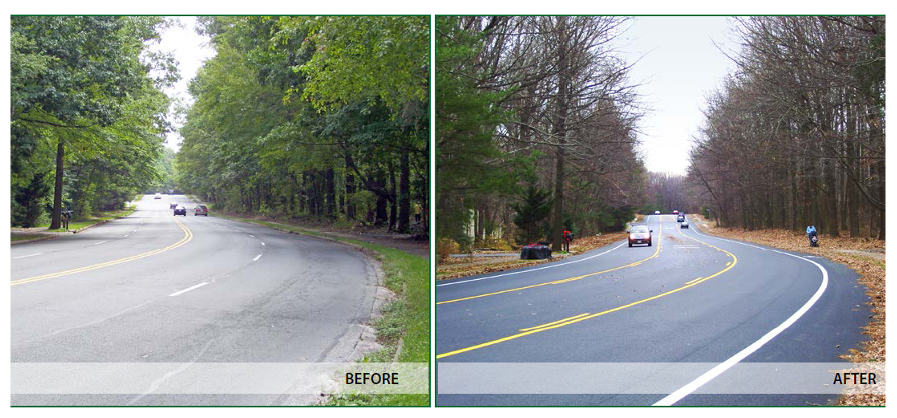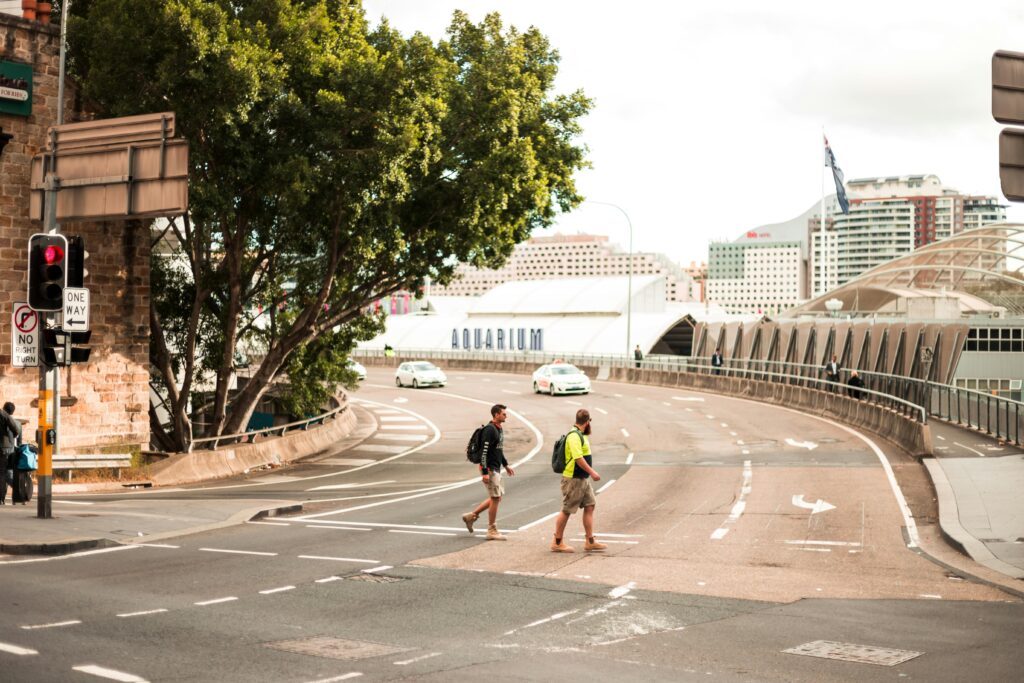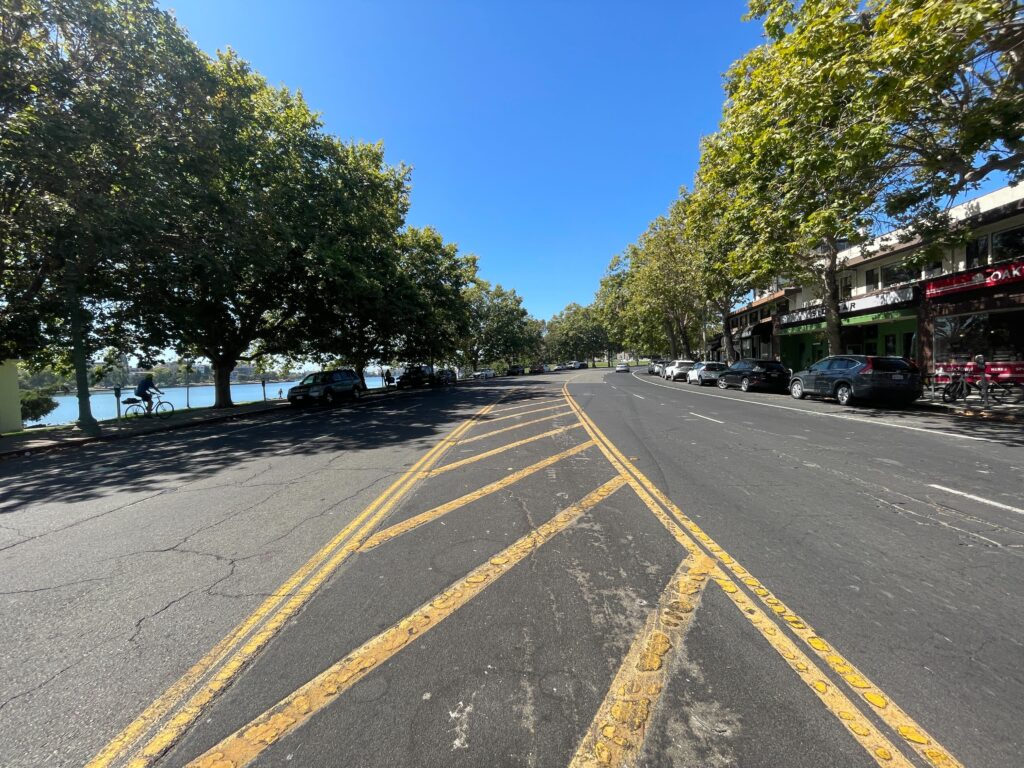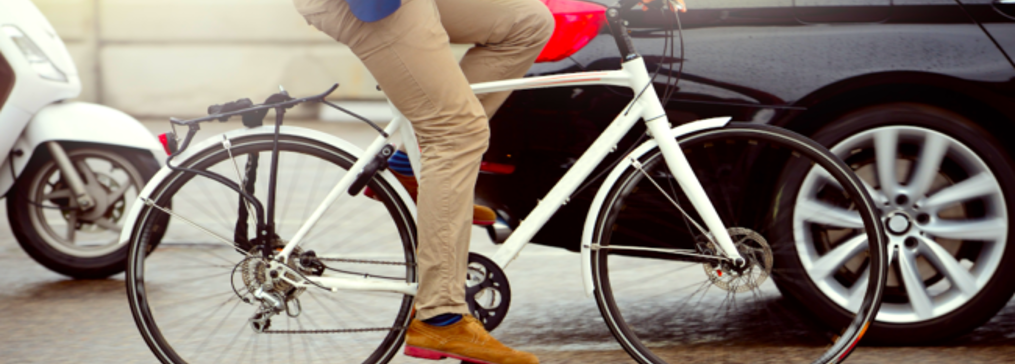
How Can a Road Diet Improve Safety for Everyone on the Road?
Jump Ahead

America’s roads just keep getting wider. According to a Washington Post report, over a third of U.S. states spent more than $19 billion on expanding existing highways and road infrastructure in 2019. [1]
It’s a common way to attempt to curb the traffic congestion plaguing U.S. cities, but many transportation buffs say it’s the wrong approach. In fact, America’s road safety troubles may be directly related to its bloated urban corridors. The data appears to indicate that, in many cases, our roads don’t need to be fed more pavement — they need a diet.
The Federal Highway Administration (FHWA) points out that undivided four-lane roads — so ubiquitous in American cities — play host to a wide range of dangerous collisions, from lane-changing side swipes to bike and pedestrian crashes. These crashes are directly related to the volume and speed of traffic, but they’re also tied to the width and layout of the road. And, while it may seem counterintuitive, the path to increased safety without worsening congestion often lies in reducing lanes, rather than adding them, through a method called road diets. [2]
In this article, we’ll explore how road diets work to increase safety not only for vehicles, but also for pedestrians and cyclists. We’ll tackle the following:
- What is a road diet?
- Key safety considerations
- How effective is a road diet?
- Considering the alternatives
- Finding the best approach with big data
So, What Is a Road Diet?
A road diet, or lane reduction, is a type of traffic calming measure designed to reduce speed and traffic congestion on an existing undivided roadway. Instead of expanding the existing road width with additional lanes, planners reduce the number of standard traffic lanes to make room for other types of lanes or road features.
Road diets are most common on four-lane highways. Typically, planners exchange the existing four driving lanes for a center left-turn lane flanked by two standard driving lanes and bike or pedestrian lanes. Other road diet examples include replacing two lanes with a tree-lined median or adding parking on the sides and narrowing existing lanes.

Whatever the specific approach, the overarching goal of a road diet is simple: to lower traffic speed and thus reduce the number and severity of crashes. In the process, this measure can also enhance the overall quality of life and appeal of an urban area by making more room for cyclists and pedestrians, expanding common areas, and even adding more green space to popular thoroughfares.
Key Safety Considerations
Understanding the value of road diets first requires an appreciation of just how threatening many of our busy four-lane, undivided roadways are. These popular road layouts are riddled with safety concerns for drivers, passengers, pedestrians, and cyclists alike. Before making any change to an established roadway, it’s essential to understand the dangers of the existing layout.
For Vehicles
In urban and suburban areas, four-lane, undivided highways are hot zones for vehicle-to-vehicle crashes. There are simply too many potential collision points for drivers to track. Such corridors are commonly home to all sorts of collisions:
- Rear-end collisions from sudden stops or vehicles waiting to turn
- Sideswipe crashes during lane changes
- T-bone or angle collisions from cars turning left across oncoming traffic
- Multi-car crashes at intersections
These collisions occur due to a range of factors, many of which can be addressed through road diets. High speed differential between lanes or intersecting streets can lead to sudden stops or miscalculations that result in collisions. Left turns across multiple lanes are also inherently dangerous. [2]
The specific traffic patterns and risks vary by location. When assessing the potential benefits of lane reductions, planners need data that allows them to analyze metrics like average speed, speed differentials, average traffic volumes, and typical turn counts at intersections.
For Pedestrians
As problematic as four-lane roads are for vehicle-to-vehicle crashes, they’re even more hazardous for pedestrians. Drivers hit and killed more pedestrians in 2022 than in any year since 1981, and these types of roads are at the center of many such collisions. [3] As one recent study revealed, 97% of the hot spots for pedestrian deaths in the U.S. are multi-lane roads. [4]

Crashes on such roads occur for many reasons, from a lack of sidewalks to pedestrians misjudging oncoming vehicles when crossing multiple lanes. However, the central problem on wide urban streets is vehicle speed. Studies show that pedestrians are five times more likely to die from crashes when cars are traveling at 40 miles an hour than at 20 miles an hour.
Here again, data is crucial for determining the right solution. Understanding vehicle speeds, the volume of pedestrian traffic, and the frequency of pedestrian collisions can help planners assess whether a road diet — and which type — would provide an effective solution.
For Cyclists
According to the National Safety Council, more than 850 cyclists died in collisions with vehicles in 2021. [5] Many of these incidents were linked to unsafe road conditions. [6] The FHWA reports that the simple addition of a bike lane could reduce bike crashes by 49% on four-lane roads. [7]
Beyond being an argument for bike lane additions, this is a strong point in favor of considering road diets on cyclist-heavy city roadways. Road diets are designed to reduce traffic speed, and they can make room for more extensive road modifications such as protected bike lanes, which are physically separated from vehicle traffic.
See how dangerous traffic speeds impact walking and biking in your region
Download Safe Speed IndexHow Effective Is a Road Diet?
Overall, the data shows that road diets are often highly effective at increasing safety. Based on broad studies, the FHWA states that road diets can reduce crashes by between 19% and 47%. [2] In Seattle, a 2008 road diet reduced pedestrian collisions by 80%. The same project saw a 35% increase in cyclist traffic without any increase in bicycle-involved crashes.
To project the impact in a specific area, planners must account for various factors, particularly existing traffic volume. Lane reductions tend to be most effective on roads with between 8,000 and 20,000 average daily vehicles. [8]
Despite these benefits, many people are skeptical of road diets. In Los Angeles, the firefighters union recently launched a campaign against proposed road diets, claiming they would hinder emergency vehicles by increasing congestion. [9] Others argue they would slow down public transportation or simply divert heavy traffic elsewhere. [8]
Broadly speaking, the evidence to support these claims is slim. Although lane-reduction projects occasionally get pulled back, research shows that these road diet failures often occur due to a disconnection between public perception and reality. In other words — the project accomplishes its goal, even if the public thinks it’s not working.
That’s not to say these tactics are the right solution for every safety or traffic congestion problem. However, the evidence does indicate that when planners closely evaluate the many variables of a situation and decide to implement a road diet, the resulting safety enhancements are usually significant. [10]
Finding the Best Approach With Big Data
As noted, road diet success is much more likely with a deep analysis of traffic patterns. Understanding metrics like turning movement counts, average daily traffic volume and speed, speed differentials, and stopping frequency is essential for an accurate assessment of any potential project.
Big data platforms like StreetLight InSight® can expedite data collection when evaluating a potential road diet, providing detailed visualizations of traffic patterns and trends to help planners conduct a thorough road safety audit before making any decisions. This approach also makes the data collection itself safer because agency staff need not put themselves at risk to take manual counts along dangerous roadways. Furthermore, big data can provide a more complete view of roadway conditions than manual counts, which are usually limited to a small snapshot of traffic during peak driving hours on a particular day or a few days.
Many agencies are already using big data to evaluate potential road diets, as well as the success of past road diets. As the video below explains, Maine’s Department of Transportation used Streetlight tools to conduct a detailed analysis of its Bangor Street road diet proposal, filling in critical data gaps to understand turning movement counts, side-road traffic, and complex roundabout traffic flows.
Similarly, a StreetLight analysis of roadway capacity, vehicle speeds, routing patterns, and pedestrian activity suggested that a road diet on Oakland’s Grand Avenue could help address safety concerns without causing major congestion.

After implementing a road diet, big data transportation analytics also allow planners to easily measure any changes in traffic volumes, routing, safety, and critical metrics like Vehicle Hours of Delay (VHD). These insights simplify the process of assessing project potential and outcomes so planners can do their work more effectively.
For more information on how big data can help you find the best safety solutions for your streets, check out our Safety Data Handbook.
- The Washington Post. “Infrastructure plan calls for fixing the nation’s existing roads. Some states are still focused on expansion.” https://www.washingtonpost.com/transportation/2021/05/23/highway-funding-infrastructure/
- U.S. Federal Highway Administration. “Road Diet Informational Guide.” https://safety.fhwa.dot.gov/road_diets/guidance/info_guide/ch1.cfm
- Governors Highway Safety Administration. “Pedestrian Traffic Fatalities by State: 2022 Preliminary Data.” https://www.ghsa.org/resources/Pedestrians23
- Journal of Transport and Land Use. “United States fatal pedestrian crash hot spot locations and characteristics.” https://jtlu.org/index.php/jtlu/article/view/1825
- National Safety Council. “Bicycle Deaths.” https://injuryfacts.nsc.org/home-and-community/safety-topics/bicycle-deaths/#:~:text=In%202021%2C%20most%20deaths%20occurred,for%20Health%20Statistics%20mortality%20data
- NPR. “More cyclists are being killed by cars. Advocates say U.S. streets are the problem.” https://www.npr.org/2022/05/25/1099566472/more-cyclists-are-being-killed-by-cars-advocates-say-u-s-streets-are-the-problem
- U.S. Federal Highway Administration. “Bicycle Lanes.” https://highways.dot.gov/safety/proven-safety-countermeasures/bicycle-lanes
- AARP. “Road Diets: A Livability Fact Sheet.” https://www.aarp.org/content/dam/aarp/livable-communities/livable-documents/documents-2014/Livability%20Fact%20Sheets/Road-Diets-Fact-Sheet.pdf
- Los Angeles Times. “Firefighters launch campaign against Measure HLA, saying ‘road diets’ threaten safety.” https://www.latimes.com/california/story/2024-02-14/firefighters-launch-campaign-against-measure-hla
- Scientific Research. “A Comprehensive Study of a Road Diet Implementation in the US and Abroad.” https://www.scirp.org/journal/paperinformation?paperid=127799#:~:text=The%20road%20diets%20were%20implemented,were%20implemented%20across%2066%20projects

See where vehicle speeds are putting all road users at risk
Download Safe Speed IndexReady to dive deeper and join the conversation?
Explore the resources listed above and don’t hesitate to reach out if you have any questions. We’re committed to fostering a collaborative community of transportation professionals dedicated to building a better future for our cities and communities.